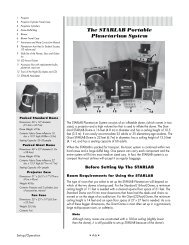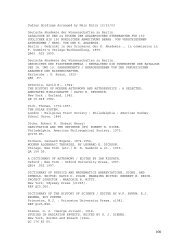K-6 Activities - Dudley Observatory
K-6 Activities - Dudley Observatory
K-6 Activities - Dudley Observatory
Create successful ePaper yourself
Turn your PDF publications into a flip-book with our unique Google optimized e-Paper software.
Series Editors: Cary Sneider,<br />
Alan Friedman, and Alan<br />
Gould<br />
Series Introduction<br />
If you have access to a planetarium<br />
for teaching about<br />
astronomy, space science, and<br />
other subjects, this series of<br />
books is for you. Designed for<br />
both experienced planetarium<br />
professionals and teachers who<br />
will be using a planetarium<br />
for the first time, these volumes<br />
provide a wealth of field-tested<br />
strategies and practical suggestions<br />
for presenting entertaining<br />
and educationally effective<br />
programs for students.<br />
The first four books provide a<br />
general orientation to astronomy<br />
and space science<br />
education with applications<br />
for both the planetarium and<br />
classroom settings. Each of the<br />
remaining volumes presents a<br />
complete planetarium program<br />
and related classroom activities.<br />
We hope you will find the<br />
materials useful in your work<br />
with students and teachers, as<br />
well as springboards for your<br />
imagination and creativity.<br />
K–6 <strong>Activities</strong> • B–40 •<br />
A Summary of Planetarium <strong>Activities</strong><br />
for Student Success (PASS)<br />
Vol 1: Planetarium Educator’s Workshop Guide<br />
Participatory planetarium programs involve students actively in the planetarium<br />
environment. The most effective programs are both entertaining and educational. This<br />
guide introduces the theory and practice of developing effective planetarium programs<br />
through a series of thought-provoking activities and discussions.<br />
Vol 2: Planetarium <strong>Activities</strong> for Schools<br />
This volume provides a wealth of effective planetarium activities for elementary and<br />
middle school students, as well as ideas for developing new activities for students of<br />
any age.<br />
Vol 3: Resources for Teaching Astronomy and Space Science<br />
There is a wide spectrum of resources for teaching astronomy and space science in<br />
elementary and middle schools. This annotated resource guide has the best resources<br />
that we have found, including school curricula, books, periodicals, films, videos,<br />
slides, professional organizations, planetariums, and telescopes.<br />
Vol 4: A Manual for Using Portable Planetariums<br />
Primarily a “how-to” manual for setting up and using a portable planetarium, this<br />
guide has many suggestions useful for teaching school programs in any planetarium.<br />
Vol 5: Constellations Tonight<br />
In this participatory version of a classic night sky planetarium program, students<br />
receive star maps and have an opportunity to use them to find constellations in the<br />
planetarium sky. Classroom activities include creating constellations and using star<br />
maps.<br />
Vol 6: Red Planet Mars<br />
Students discover Mars three different ways during this planetarium program. They<br />
find the red planet by observing it over a period of several nights as it moves against<br />
the background stars. Then they view it through a telescope and try to map its surface.<br />
Finally they see Mars via space probes. Classroom activities involve students in<br />
modeling the solar system, and creating creatures that could survive under different<br />
planetary conditions.<br />
Vol 7: Moons of the Solar System<br />
This program begins with observations of the earth’s moon and a modeling activity<br />
that shows why the moon goes through phases and eclipses. Then the students look<br />
at Jupiter’s four major moons on a series of nights and figure out how long it takes<br />
one to circle Jupiter. Finally, the students journey through the solar system to see many<br />
moons through the “eyes” of modern spacecraft. Classroom activities involve students<br />
in performing experiments in crater formation, using moon maps, and designing<br />
lunar settlements.<br />
Vol 8: Colors from Space<br />
What can we learn about the stars and planets from their colors? Answering this<br />
question requires a fundamental understanding of why we see color. During this program,<br />
students deepen their understanding through a series of activities in which they<br />
“travel” to an imaginary planet circling a red sun, and experiment with color filters





